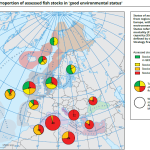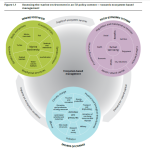Our seas are neither healthy not clean, but can be considered productive according to the first State of Europe’s Sea report published earlier this week. This productivity may however be compromised in the future if the decoration of Europe’s marine ecosystem continues. The report shows that our current way of managing our marine resources is far from sustainable.
Earlier this week the European Environment Agency (EEA) released its first State of Europe’s Seas report. The findings from the report show that, despite some improvements made over the last years, the way we use our seas remains unsustainable which not only threatened the productivity of our seas and marine ecosystems but also our own wellbeing.
The report is the first EU-wide assessment of the status of European seas against goals set under the Marine Strategy Framework Directive (MSFD) of having healthy, clean and productive seas. It also considers the main sustainability challenges affecting our seas and how the EU is responding to these. The report shows that 58% of the assessed commercial fish stocks are not in good environmental status (GES), with 40% of EU catches remaining unassessed, making it impossible to assess weather their status has improved. Furthermore, only a limited number of assessments of marine habitats and species indicate GES, only 4% of marine species are considered to be in GES. The current state of Europe’s seas, as presented in the report, does not go well in hand with EU’s Blue Growth agenda.
The report indicates that thematic policy instruments dealing with single ‘traditional’ issues, such as overfishing, eutrophication and biodiversity protection have led to improvements of the state of Europe’s seas. However, “in order to address the increasing complexity of the problems faced by our seas, governments must implement these policies in an integrated way”. The best way forward to achieve a desired policy integration is to apply the ecosystem-based approach. An approach which offers an opportunity to ensure that fishing and other human activities can develop according to the limits of the ecosystem. This shift might be easier said than done as it would require changes within management procedures and traditional policy used today. However, from a long-term sustainable fisheries perspective, the report concludes that with the new CFP and the MSFD the opportunity to do this is within the EU’s gasp.
Humans have relied upon the sea to support their daily lives for centuries. How long can we keep on doing so? If we focus solely on short-term economic gains, we put ecosystems – and our own basic needs, well-being, and livelihoods – at risk. Unfortunately, it appears that the way we use Europe’s seas natural capital is not sustainable.
The key findings of the report include:
- Most of the assessed commercial fish stocks in European seas (58%) are not in ‘good environmental status’ (GES), while 40% of EU catches remain unassessed, making it impossible to assess whether their status has improved.
- Total catches in all fishing regions have been declining in the past ten years. EU is increasingly dependent on imports of its most widely consumed species: tuna, cod and salmon.
- The status of 80% of assessed species and habitats is ‘unknown’; only 4% are of ‘good’ status and 2% of the known features are of ‘bad’ status.
- 100% of assessed ecosystems have an ‘unknown’ status.
- Marine litter, mainly in the form of plastic, is accumulating in Europe’s seas. Where the majority of the litter comes from land-based activities
- Underwater noise from human activities (shipping, renewable energy, oil and gas extraction, etc.) is increasing and can have a wide range of impacts on fish and other marine life.
- Signs of improvement are observed in certain pressures, such as fishing and nutrient loading.


